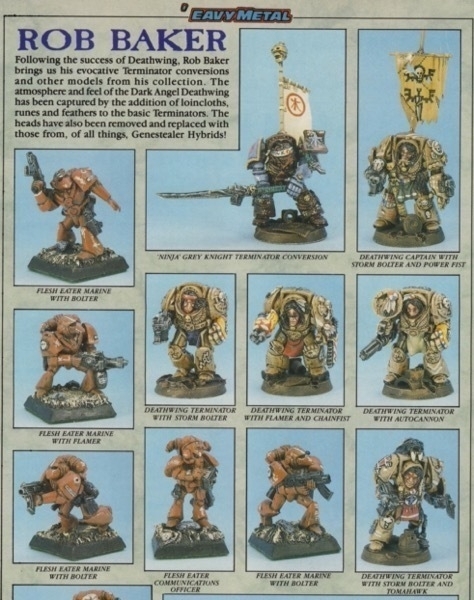Writing about the (hearsay) reasons for the Dark Angels’ color change last week got me curious about how the chapter’s look and story developed over the early days of Warhammer 40,000. Naturally, this led me to pour through PDF copies of Rogue Trader and every White Dwarf magazine released through the second edition of the game. Below I’ll lay out the timeline for how both the story and the look of the army changed over the years.
In short: The Dark Angels start off wearing black until a Jim Burns painting shows them with a green cast (Sep ’89). The Ravenwing as a mobile company was established early on (Dec ’87). Lion El’Jonson’s rivalry with Leman Russ is mentioned but little else is established. The Deathwing were added with the release of the Space Hulk Deathwing expansion, which orignated their American Indian motif and white armor (Nov ’89). The “Unforgiven” story didn’t come along until quite late, appearing in a short blurb in second edition’s Codex Imperialis in ’93 but not fleshed out until Codex: Angels of Death in ’96.
Here’s a timeline of every time the Dark Angels were mentioned that I found. (I’m sure I missed some but I hope you’ll agree this is thorough enough). I’m using the White Dwarf cover dates, which might be slightly off from their actual street date.
Prehistory: I can’t begin without mentioning Lionel Johnson and his poem, The Dark Angel. I don’t have any information as to whether GW came up with the name Dark Angels and then discovered the poem or if someone knew of the poem first, but the chapter’s Primarch is definitely named for the poet and its story of shame and concealing a dark secret is a likely inspiration for the chapter’s backstory.
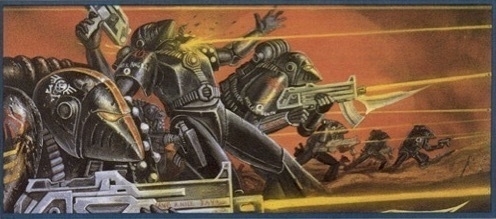
1987’s Rogue Trader has only a little background information about the discrete Space Marine chapters. Page 12 has several examples of Dark Angels wearing all black with a red stripe down their helmet.
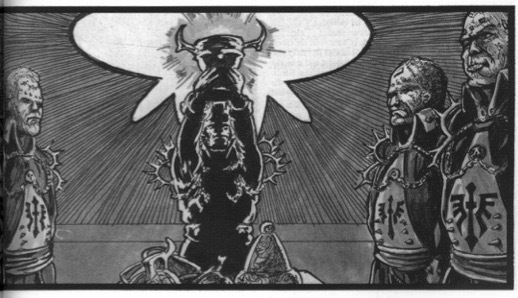
Page 138 describes the Feast of the Malediction:
The celebration of the Feast of Malediction by the Dark Angels Chapter of Space Marines. This great annual event takes place in the Seclusiam of the Dark Angels’ space fortress which orbits the giant planet Delahon. The feast celebrates the founding of the Chapter by Lynn Elgonsen at the beginning of the Imperial Crusades almost ten thousand years ago. The Dark Angels are honoured as the first Marine Chapter. They were founded by the Emperor at a time when he still lived in the conventional sense. Within the Chapter the title of the Dark Angels’ leader is Custodian, an honour which acknowledges the Emperor as the Chapter’s true leader. The Cup of Retribution used in the ritual is said to be the actual vessel from which the Emperor drank at the original founding of the Chapter. At the culmination of the feast, the Custodian takes a small knife and cuts his thumb so that a drop of blood falls into the cup. The cup is then passed around the all the assembled fighting brethren who each add a little of their own blood. Once very warrior has contributed, the contents of the cup are mixed with wine in a number of large open barrels. The cup is then passed from warrior to warrior, each filling it and drinking from the wine in turn. This ancient ritual is sacred to the Dark Angels and it is considered a bad omen is a long campaign or sudden battle delays the feast.

Page 156 describes Space Marine armor colors and badges. “The Dark Angels wear only black.”
White Dwarf 93 (September) announces Rogue Trader and the world of Warhammer 40,000. A two-page spread describes the dark future and the Emperor and includes a Dark Angels logo among several other chapters’. A spread showing the plastic “Imperial Space Marines” says, “There are a thousand different Space Marine Chapters including such renowned names as Spacewolves, Crimson Fists, Dark Angels and Silver Skulls.” A spread in WD 94 shows some black-colored Dark Angels miniatures.
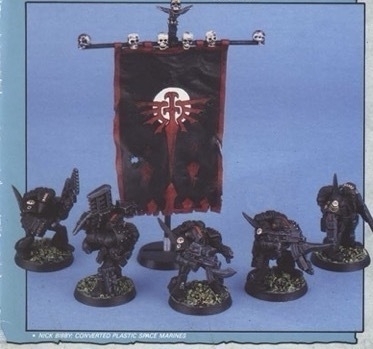
White Dwarf 96 (December) has the first “Chapter Approved” article, on the Mk14 Jet-Cycle “Bullock.” It highlights “The Raven Wing,” which at this point was the seventh company (not second) and deployed exclusively on jet-cycles:
There are ten companies (each of a hundred battle-brothers) making up the fighting brethren of the Dark Angel chapter of Space Marines. […] Number seven company is a specialised recon and attack company, known as the “Raven Wing.” Instead of the usual Dark Angel motif Brothers of the company sport a black wing overlaid by the company number on the right shoulder Armour. Equipped and trained for high-speed reconnaissance, the Raven Wing specialises in hit-and-run warfare and search-and-destroy missions.
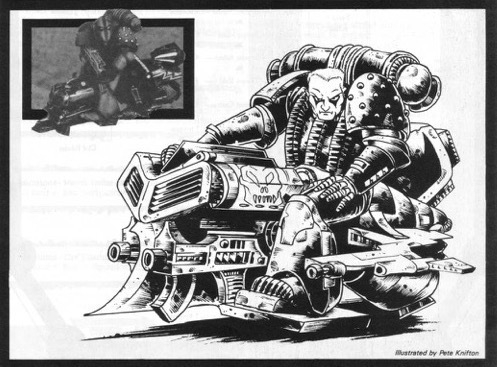
The Primarch is named for the first time, though his name and story at this point are depicted as partially lost to history:
History. The Raven Wing’s exact origins are lost in the history of the First Crusade (circa thirtieth millennia—about ten thousand years ago). Indeed little is known about the Dark Angels during that time. The Chapter’s early history was removed from all Imperial records following the Horus Heresy and the banishment of the nine “treacher-legions” to the Eye of Terror. The reason for the erasure is now known only by the Emperor himself.
According to legend, the Chapter was founded by Lynel Jacobsen or Jonsen, a man whose reputed exploits include the incineration of Goyas Asteroid and the first sub-light circumnavigation of the Outer Dolmans. He is said to have died defending the honor of the chapter in a duel with Leman Russ (founder of the Spacewolves). This may be true, but it is more likely that the story was invented following the inter-legionary wars in the thirty second millennia. In any case, the two chapters have remained rivals at best (and outright enemies at worst) ever since.
It goes on to detail a battle over Rynns World featuring ten Raven Wing squads plus its captain and staff. The force was led by Captain Gaius Oblonsky, Lieutenant Djinn Ntonnik, Medics Kyle Kildare and Cassius Hacit, Astropaths Vedi Lazar and Rumman Koak, and Communications Mayer Rufus and Clof Bibulus. Squads were broken into two combat squads of five, led by a sergeant or the next-most senior Battle Brother. Names given are Lex, Gorz, Logos, Palchis, Albius, Habz, Tegulus, Malsh, Salireh, Kuhn, Credens, Erek, Capsus, Kanz, Eboracus, Lowg, Vincius, Dukh, Casula, and Vengt.
1988
White Dwarf 102 (June) has an “Index Astartes” feature on medics. It shows a Dark Angels medic in black but with a white torso and power pack.
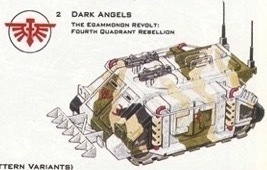
White Dwarf 103 (July) has a Dark Angels Rhino in a “Sub-Attic Tundra” camouflage pattern.
White Dwarf 105 (September) has an “Index Astartes” article which notes, as an example of “Variation from the Codex”: “A good example of organisational variation is provided by the “Raven Wing of the Dark Angels Chapter. This entire company is equipped with M14 Bullock jet cycles as appropriate to their high speed reconnaissance role.”
White Dwarf 108 (December) describes Space Marine Chaplains. It has a guide to “Typical Chaplain uniform variations,” which lists Dark Angels Chaplains as wearing skull helmets, black torsos and legs, and skull shoulder pads.
1989
White Dwarf 112 (April) shows a Dark Angels Terminator still in black armor.

The cover for White Dwarf 117 (September) is a Jim Burns painting that was also used as the front of the Space Marine (Epic) boxed set along with metal band D-Rok’s Oblivion. The marines on the cover are definitely green, though I’ve seen other reproductions of the artwork where they’re much darker—black with a green tint rather than green. Regardless, more or less from here on, Dark Angels wear green.
The ’89 Space Marine rulebook, page 61 has a section on “Uniform Colour and Banner Chart.” It says the Dark Angels’ base coat should be black with a highlight of Salamander Green.
WD 117 has a feature on Leman Russ that mentions the Dark Angels, expanding on the story from WD 96. The Dark Angels’ Primarch now has his current name:
On the world of Dulan, the Space Wolves and Dark Angels were to assault an enemy held fortress. Russ claimed the right to lead the attack, but “Lion” El’Jonson, commander of the Dark Angels, refused and started the attack early. Russ was furious, and began a feud which was to continue for three centuries. The Emperor intervened to quell the fighting, and ordered that the disagreement be settled with a duel. Leman Russ faced his friend in combat and took a blade through the heart; the duel was declared a draw, and the normally fatal wound healed within weeks.
The Primarchs were to fight four more times before the death of El’Jonson. Friends to the end, they were united by shared rivalry and sense of honour. The feud would arise again, but not in Russ’s lifetime.
White Dwarf 118 (October) has an ad for Space Marine transfer sheets for Space Wolves, Ultramarines, Blood Angels, and Dark Angels. These are now the four main chapters Games Workshop will feature going forward.
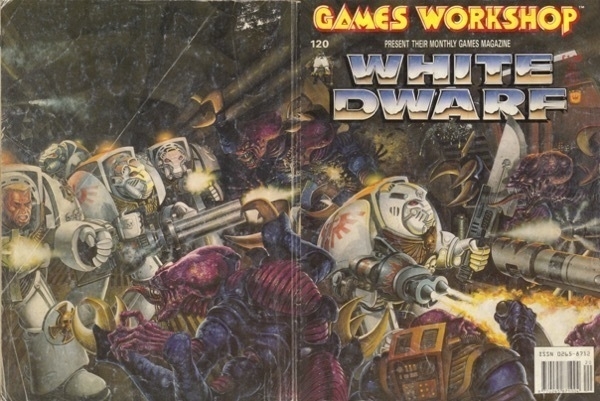
White Dwarf 119 (November) announces the “Death Wing” expansion of the Space Hulk game. №120 (December) has a Deathwing front and back cover. The Deathwing now wear pure white armor, not the more yellowed bone/cream color in current use.
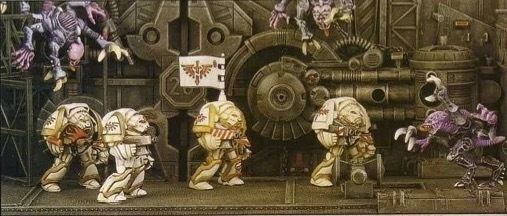
The Deathwing game also saw release of a short story by Bryan Answell and William King. It included art by Kev Walker (and maybe others) that gets featured in many WD issues over the next few months. Established in this story:
- The Dark Angels recruited from a planet called Plains World. Their culture, as explained later in WD 195, had a population that “shared many of the traits of the Native American Indians of our own planet.”
- The names of the Deathwing troopers include Two Heads Talking, Weasel-Fierce, Lame Bear, Cloud Runner, Bloody Moon, and Eagle Wing. It notes that when they joined the Dark Angels, they took on other names such as Ezekiel.
- In the story, the Terminators repaint their armor white, which represented the color of death (bones). After the mission, all Deathwing are colored white in honor of their victory over the Genestealers in the story.
1990

White Dwarf 122 (February) has Eagle Wing on the cover, an ad for Space Hulk and the Deathwing expansion featuring some Dark Angels Terminators (still in pure white), and some Deathwing Terminator artwork.

White Dwarf 123 (March) has the first Dark Angels miniature wearing green in an ’Eavy Metal section.
White Dwarf 126 (June), in an article on Epic Space Marines, which is set during the Horus Heresy, describes the “Regimental Organization of the Founding Chapters”:
The Dark Angels have a powerful attachment to the rituals and traditions of their homeworld. In honour of their ancestors, they apply the ancient precepts of battle to their forces: find your enemy’s weakness, test your skills against him and then make the killing blow. To this end, a Dark Angel regiment often has the three companies of the 1st Battalion dedicated to this ideal: Death Wing, Iron Wing, and Raven Wing. Sometimes the entire regiment is organized on these lines but this is rarer.
The Death Wing, Iron Wing, and Raven Wing are called the 1st, 2nd, and 3rd companies, respectively.
An ad for the Space Hulk Genestealer expansion shows an illustration of a Deathwing Chief Librarian in white but with yellow (or gold) trim. An ’Eavy Metal miniature has a Deathwing Terminator painted in this scheme: white with some yellow shading and yellow trim.
White Dwarf 127 (July) has an ’Eavy Metal spotlight on Rob Baker showing off some Deathwing conversions with lots of American Indian influence. For the first time we see a Deathwing Terminator with feathers, which would become a key piece of their iconography. The next issue has a Terminator Librarian in the ’Eavy Metal section.

White Dwarf 129 gives us an article on Space Marine armor types and a feature on Tactical Squads. It shows Dark Angels wearing green but adhering to the Codex convention of using company colors for shoulder trim (and also chest eagles). We also see a Deathwing marine in Power Armor.
The Dark Angels are instantly recognisable by their traditional very dark green colour scheme. The chest eagle motif varies in colour depending on the company as described below. The left shoulder armour plate bears the Chapter badge in yellow with a trim in the company colours (ie same as the chest eagle). Tactical Squads are distinguished by a plain horizontal double-headed white arrow on the right shoulder. An alternative version is a simple white band alongside the rear edge of the armour: this is an especially common adaptation during long campaigns but it has become an acceptable alternative to the standard arrow either for whole squads or individual Marines. Another alternative is a double-headed arrow in outline only.
The codex dictates that the arrow bears the squad number in the company colour and that both shoulder pieces should be outlined in the same colour. However the Dark Angels do not stick as rigidly to the codex as the Ultra Marines, and many squads do not display the squad number or it may be worn only by the Sergeant. Sometimes the number is not in the company colour but is black or white instead—this is a common compromise during a campaign. Similarly the edging trim colour is often missed off the shoulder and the chests eagle may be the same colour as the armour. Sergeants are distinguished by the white Chapter insignia instead of their brother Marine’s normal yellow. Individuals companies are identified by the colour of their chest eagles, shoulder trim and Squad numbers as follows:
Chest Eagle colors. 1st Co. - dark green, but the 1st company is an exception to the normal rules as described below, 2nd - white, 3rd - red, 4th - yellow, 5 - black, 6th - grey, 7th - light green, 8th - blue, 9th - purple. As with the Ultra Marines the 10th company is considered as a reserve or training company and as such as no Tactical Squads and so is not illustrated here.
The exception to this overall scheme is the 1st Company. The 1st Company is made up of Marines who would otherwise wear Terminator armour and comprise the famous Death Wing. Just as the Death Wing traditionally wears all white armour, so the 1st Company has all white power armour. The Tactical Squad markings and other details that would normally be white are black. The chest eagle is the same green as the normal armour colour while the Chapter badge itself is red rather than yellow.
White Dwarf 130’s ’Eavy Metal pages show Deathwing in Power Armor and a Dark Angel Scout (October).
In №132 we have (December) Deathwing Terminators painted by Stuart Willis that look more like the current style—white with a wash of brown and yellow.
1991
A new version of Space Marine came out. Page 30 of the rulebook has brief background on the Space Wolves, The Dark Angels, The Ultramarines, and The Blood Angels:
The Dark Angels are age-old rivals of the Space Wolves. When they fight together each Chapter will try to outdo the other, recalling the ancient rivalry between the two original founders of these Chapters: Leman Russ Primarch of the Space Wolves, and Lion El’jonson Primarch of the Dark Angels. On eleven occasions in their history the two Chapters have gone to war against each other, the most recent being the Magdelon War in which the Space Wolves finally ousted the Dark Angels from the second moon of Magdelon and its famed gem mines. The Dark Angels uniform is very dark green and their badge is the winged dagger.
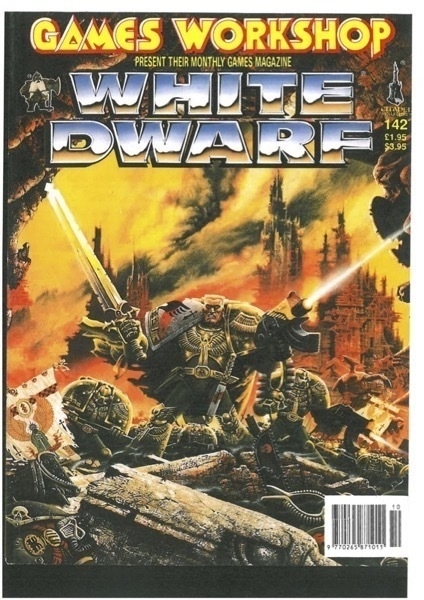
White Dwarf 142 (October) has Dark Angels on the cover, painted by Geoff Taylor. In a painting guide article for the Space Marine game we get the first mention (I think) of the Ravenwing being black. At this point the guidance still has the Dark Angels using different colors for each company like a regular Codex chapter:
- Deathwing: Skull White
- Ravenwing: Chaos Black
- Battle: Goblin Green
- Battle: Hobgoblin Orange
- Battle: Blodo Red
- Tactical: Enchanted Blue
- Tactical: Worm Purple or Grey
- Assault: Moody Blue
- Devastator: Sunburst Yellow
- Scouts: Salamander Green
The Dark Angels are slightly different to the other two Chapters described above [Ultramarines, Blood Angels] in that they have a slightly different mix of company types: one less Battle Company and a new type of company called the Ravenwing. This is a mobile mounted company riding fast vehicles, bikes and speeders. The basic uniform colour of the Dark Angels is Salamander Green, a rich dark green colour, but there are two exceptions. The Deathwing is the name of the Dark Angels’ Veteran Company and wears all white armour; the Ravenwing wears all black armour.
The company colour is optionally used for the right shoulder pad, but the company banners are all black except for the Deathwing’s, which is white. Each company HQ unit’s banner has the Dark Angel’s symbol, a winged dagger, in its own company colours except that the Deathwing has a black symbol, the Ravenwing a white symbol, and the Scouts have an unwinged dagger in either white, yellow, or red. These badges are not always used—they are optional and you may prefer to miss them off as indeed the Dark Angels themselves will sometimes do in combat. Shoulder pads can also be painted with company colours if desired.
Here and elsewhere it’s mentioned often in this era that Space Marines are not consistent about their uniforms. Marines in a particular campaign might use coloring and markings that are different than others’. (This is, of course, good story cover to explain why different players’ armies look different.)
1992
White Dwarf 146 (February) has Dark Angels Scouts on the cover and a diorama of Dark Angels called The Last Stand. It depicts a Deathwing marine in Power Armor.
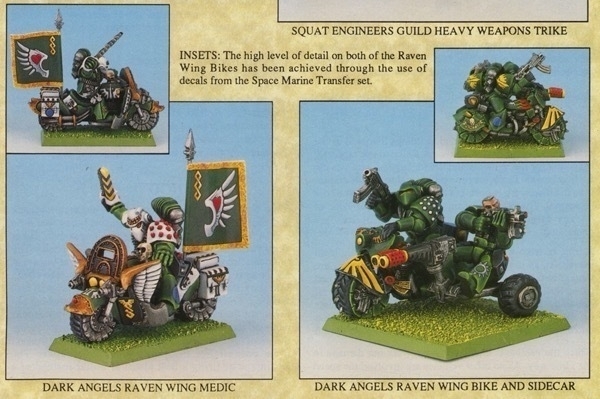
White Dwarf 149 (May) shows off Ravenwing bike models painted green. The medic flies a banner with a wing that looks very close to the current Ravenwing insignia, minus the sword/dagger in its hand.
Raven Wing Bikes: The Raven Wing is the second company of the Dark Angels Space Marine Chapter. It is completely mobile, which makes it a quick and deadly attacking force.

The next several issues have a few models. White Dwarf 150 (June) prints some wonderful John Blanche Dark Angels art. 152 shows a Dark Angels Captain, 155 has a cover by Dave Gallagher showing bikers in green. (From here on I’m going to skip issues that just show a Dark Angels model unless they’re notable in changing the look in some way.)
1993

White Dwarf 161 (May) introduces the new metal Deathwing models. An article by Andy Chambers shows off new rules for using them in game and reiterates the story about why the color their armor white. It also says that the “Deathwing is particular blessed in that it has one hundred suits of Tactical Dreadnought armour, enough to equip the entire company.” The story hasn’t yet solidified around the idea that the Dark Angels’ first company only wears Terminator Armour, but it’s getting there. It also starts to build up the idea that the Dark Angels have a wealth of equipment that other chapters don’t—not every chapter can put its entire first company in Terminator Armour—they just don’t have that many suits.
Later in that issue is an article on the Horus Heresy. The Dark Angels only get a brief mention. Note the “h” in the Lion’s name:
A loyalist fleet under Leman Russ and Lion’el Johnson bearing a fresh army of Space Wolves and Dark Angels was only hours away. It would take days to break humanity’s last citadel, even with Horus leading his troops. It seemed that time had run out for the Warmaster, that his gamble had failed.
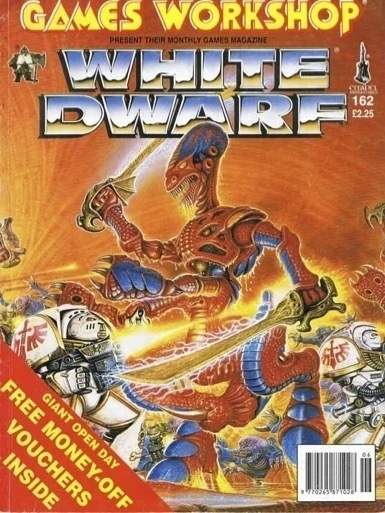
White Dwarf 162

White Dwarf 163

White Dwarf 166 (October) shows off the new Dark Angels Tactical Squad box, complete with a special sergeant model. Second edition is being released and the Dark Angels color scheme is now fairly fixed. Red Boltguns, no special shoulder trim, bone chest eagles.
It includes a section taken from the second edition’s Codex Imperialis book, which finally starts to establish the story of the Dark Angels:
Of the Battle Brothers of the Dark Angels history cannot speak, for there are no records of the Dark Chapter’s beginnings, of their part in the Great Crusade, or of their deeds during the terrible wars of the Horus Heresy. Only the legend persists—the legend that once the Dark Angels teetered upon the brink of Chaos, that foul betrayal besmirched the Chapter’s valour and made vain all acts of former virtue. Yet they returned to the fold of the Emperor’s love and tore themselves from the very bosom of temptation. Perhaps they sought the Emperor’s pardon too late, for ever since they have borne the Mark of the Unforgiven. Can ten thousand years of purgatory absolve those to whom every battle is redemption? Can it be the lost souls of the slain that clamour for the absolution that victory brings?
The next few dozen issues feature Dark Angels models here and there but no major story changes. The Dark Angels get a Dreadnought with Missile Launcher and Assault Cannon and a Predator kit (which is just a regular Autocannon loadout).
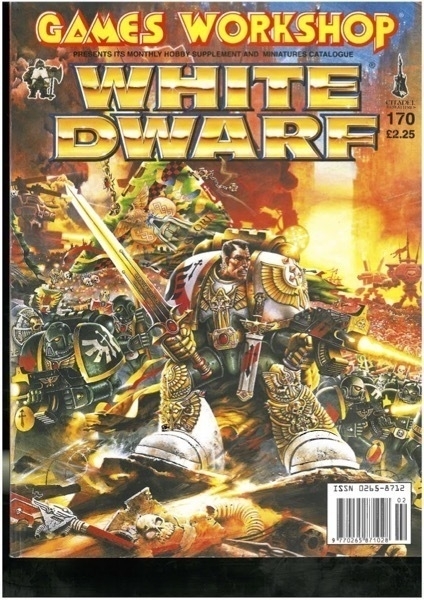
White Dwarf 170
1996

January ’96 sees the release of Codex: Angels of Death, announced in White Dwarf 193, one hundred issues after Rogue Trader’s preview in №93, along with new robed Dark Angels characters. A feature by Jervis Johnson, “Dark Saviors,” talks about new characters Azrael, Ezekiel, and Asmodai. The following issue shows standard bearer Brother Bethor.
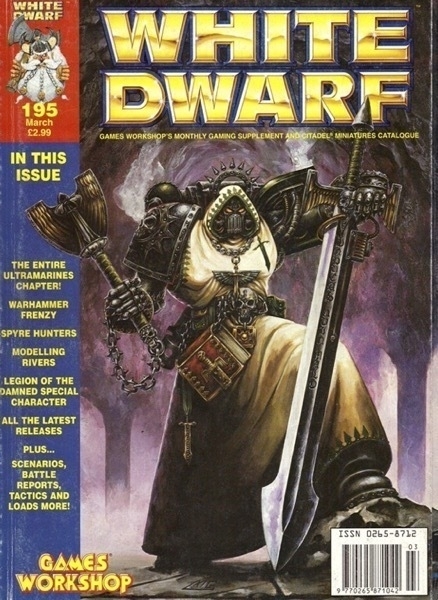
Codex: Angels of Death establishes the story of the Dark Angels, including the hunt for the Fallen, the aesthetic of characters wearing robes, and so on. The next several issues of White Dwarf show off the new miniature line of characters, including a new Ravenwing Land Speeder and a new set of bikes, now all painted black.
What did I learn from all of this (aside from that if you know where to look, you can find PDFs of old White Dwarf issues and rulebooks)? I had thought that the general storyline of the chapter—the hunt for the Fallen—had been in place longer, or had developed over time. In actuality, it was written more or less entirely by Rick Priestley and Jervis Johnson for the second edition codex. Clearly some tidbits germinated before that, starting with the short bit in Codex Imperialis, but I wasn’t able to find anything else about it, aside from a mention of their early records being stricken, prior to then. I do find it fascinating how in addition to crafting this new Unforgiven story, they brought in elements from the previous ten years. The use of a mounted company in the Ravenwing, the idea of a mobile HQ rather than a home planet, the feud between the Lion and the Wolf, and Deathwing Terminators were all brought together and made into one cohesive story. There’s even a little retcon, mentioned in passing about the Angels of Absolution’s armor color, explaining the chapter’s color change to green from black. Extra special credit goes to the way that the story of the Deathwing on Plains World finding their planet had been corrupted by Genestealers is turned into story that’s told to young Dark Angels recruits as a metaphor for the need for constant vigilance against corrupting influence with an eye toward preparing them to hear the story of the Fallen. Great stuff.
Also reading those earlier White Dwarf issues just reaffirmed to me how much personality the original “beakie” models had. I get that the new Primaris models have a better scale to them and look more fearsome, but the old figures were just so expressive!
More in this series:
- Shoulder Pads of the Dark Angels
- Dark Angels Apothecaries
- Why the Dark Angels Really Changed from Black to Green?
- How the Dark Angels story developed, from Rogue Trader to 2nd edition
- Successor Chapters
- My 4th company, “The Feared”
- The Deathwing: History and Complement
- Dark Angels Decals: A Look at Waterslide Transfer Sheets
- The Ravenwing, the Dark Angels’ Cavalry
